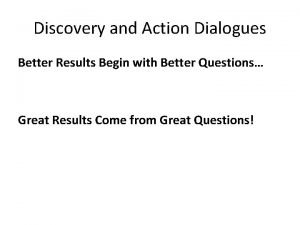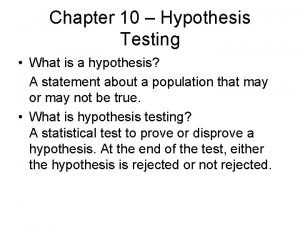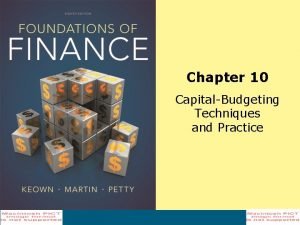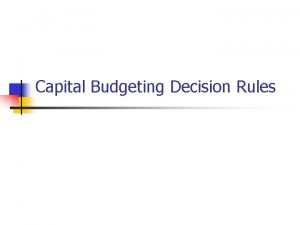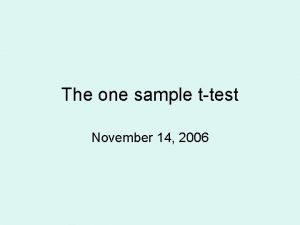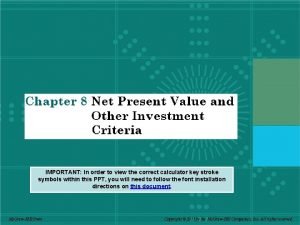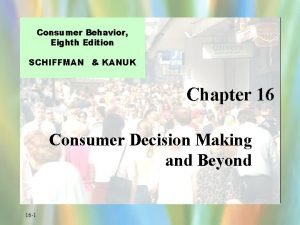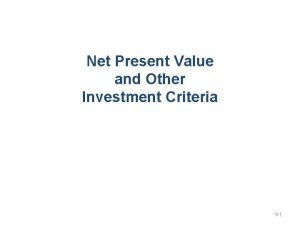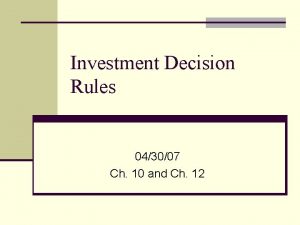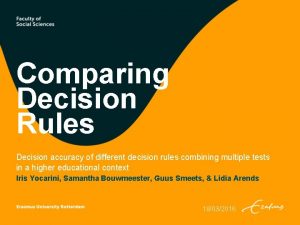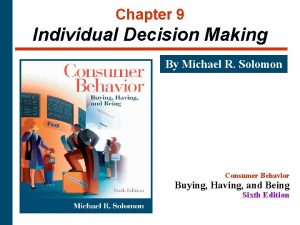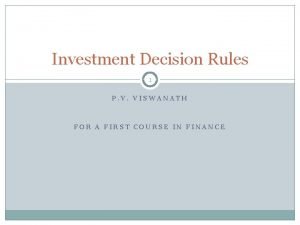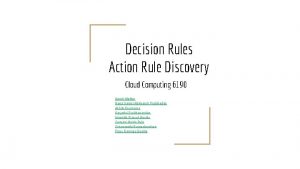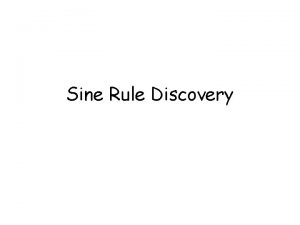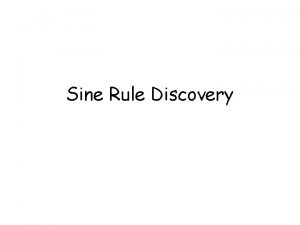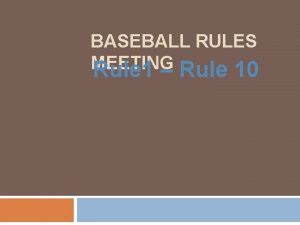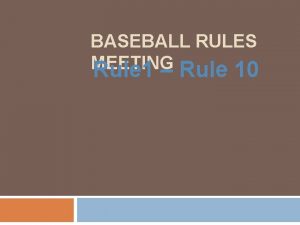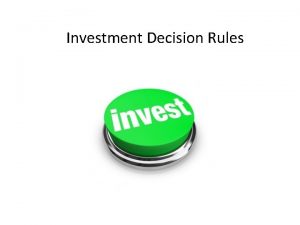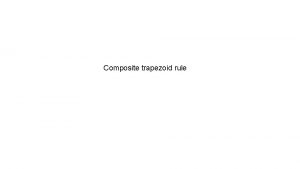Decision Rules Action Rule Discovery Group 10 What
















- Slides: 16

Decision Rules Action Rule Discovery Group 10

What is LERS ? Slide title, level 1, Arial 40 pt, bold Su ●Stands for Learning from Examples based on Rough Sets. ●It allows us to generate rules, which have a specific attribute on the right hand side of the rule, called as decision attribute. ●Set of Customers being Profitable/Non-Profitable ●Set of Tumors being Malignant/Benign ●LERS works based on the concept called as covering. – formatting if so desired Subtitle or section title #2, Arial 30 pt, bold

Slide title, Coverings , Arial 40 pt, bold S ● Set P is a covering of set R if P is a subset of R ● We do not have a smaller set, which is a subset of which implies P is the smallest. P* ≤ R* ⌐ ( ∃Q⊆ P) [P* ≤ R*] ● For Example, {a} is bigger than {a, b} (and {a, b} is smaller than {a}) because {a} is more general than {a, b}, in other words, {a} includes {a, b} • list, Arial 28 pt – Sub points are 26 pt. – Can use pre-defined bullet formatting – Can customize bullet formatting if so desired

Question What is LERS

Steps to Generate LERS Rules x A B C Classification attribute: {A, B} x 1 0 0 0 Decision Attribute : {C} x 2 0 1 1 Step 1: We find the coverings of {A, B, C} and check if coverings of the classification attribute are the subset of coverings of decision attribute and mark them. x 3 0 0 0 x 4 0 1 1 x 5 1 1 2 x 6 1 1 2 x 7 2 2 3 x 8 2 2 3 X = {x 1, x 2, x 3, x 4, x 5, x 6, x 7, x 8} {C, 0}* = { x 1, x 3}; {x 2, x 4 }; {C, 1}* = {C, 2}* = {x 5, x 6 } {x 7, x 8 }; {C, 3}* = {A, 0}* = { x 1, x 2, x 3, x 4}; (Marked) {B, 0}* = { x 1, x 3} ⊆ {C, 0} {A, 1}* = { x 5, x 6} ⊆ {C, 2} (Marked) {B, 1}* = { x 2, x 4, X 5, X 6}; {A, 2}* = { x 7, x 8} ⊆{C, 3} (Marked) {B, 2}* = { x 7, x 8} ⊆ {C, 3} (Marked)

Steps to Generate LERS Rules cont. . Step 2: From the generate rule sets in the first loop, Certain rules are generated from marked sets and possible rules are generated from unmarked sets. Certain rules have confidence of 100%, but possible rules have different confidence which is <100% Certain Rules: Possible Rules: (a, 1) → (c, 2) (a, 0) → (c, 0) with confidence = 1/2 (a, 2) → (c, 3) (a, 0) → (c, 1) with confidence = 1/2 (b, 0) →(c, 0) (b, 1) → (c, 1) with confidence = 1/2 (b, 2) → (c, 3) (b, 1) → (c, 2) with confidence = 1/2 (a, 0) & (b, 1) → (c, 1) Step 3. Next, if there are unmarked sets in the First Loop, then we go to a Second Loop, by combining the unmarked sets together. Continue the process until there are no unmarked sets.

Question Which sets are used to generate certain rules?

Practical Examples LERS (Learning from Examples based on Rough sets) : ● LERS was developed at the University of Kansas and it is a family of data mining systems. This system is universal and it helps to compute rules for any kind of data. ● In LERS the set of rules that was induced previously is apted to find new rules. Furthermore, it compute rules from imperfect data, like datas with missing values or inconsistent cases. ● The benefit of using LERS is, it handles inconsistencies and does not require any preliminary or additional information about the data. In this method, the inconsistencies are not removed entirely, instead lower and upper boundary approximations of the concept are computed.

Practical Examples Some practical examples are: • • Finance industry -- to decide whether to give a loan. Medical industry -- decision support for diagnosing. Military --- evaluation of job performance. NASA --a tool to be used in medical decision making on board the International Space System.

Action Rules: ● Constructed from certain pairs of association rules to suggest a way to re-classify objects to a desired state ● Attributes in decision table is partitioned into conditions & decisions Attributes (Decision Table) Stable Flexible

Action Rule Cont. {a, c} - Stable Attributes {b, d} - Flexible Attributes Rules: r 1 = [(b, P) ->(d, L)] r 2 = [(a, 2) ^ (b, s) -> (d, H) Action Rule : [(b, P-> S)](x) => [(d, L-> H)](x)

Cost Of an Action Rule: ●Every action is associated with a specific cost. ●Types of Costs: a. Monetary cost b. Moral cost Example: Relocating a team from one city to another (re-classifying the employees from one division to another) may cost us the moving expense(monetary Cost), in addition to a moral cost – some negative emotions of the employees about it may influence his/her future performance or perception of our organization.

Cost Of an Action Rule: ● Cost is denoted by ‘ρ’ ● The range of ‘ρ’ is [0 to + ∞] ● The cost(ρ) will be close to zero if the action is trivial(if the action is easily accomplished) ● The cost(ρ) will be close to +∞ if the action is very difficult to accomplish.

Practical Examples of Action Rules: In the Action Rules Method the attributes in the database must be split into two groups: stable and flexible. Binding to Thrombin (Key receptor in blood clotting) ●Classify active and inactive compound receptors to design new drugs Benchmarking in Insurance Companies for certain policies ●Reclassifying attributes in a car policy from 5 to 6 ●Allows to better market different policies to certain customers

Practical Examples of Action Rules: Breast Cancer Diagnosis ●Classifying a tumor as benign or malignant ●Ability to provide suggestions or actionable rules to be made in order to changes the class from malignant to benign ●Better classification of when a tumor should be immediately removed because it could be life threatening.

THANK YOU
 No decision snap decision responsible decision
No decision snap decision responsible decision Slidetodoc.com
Slidetodoc.com Discovery and action dialogue
Discovery and action dialogue Decision table and decision tree examples
Decision table and decision tree examples Decision rule statistics
Decision rule statistics Profitability index decision rule
Profitability index decision rule Consumer decision rule
Consumer decision rule Decision rule of npv
Decision rule of npv Decision rule for t test
Decision rule for t test Mirr method
Mirr method Intergroup gifting
Intergroup gifting Npv meaning
Npv meaning Modified irr
Modified irr Iris yocarini
Iris yocarini Rules of outline
Rules of outline Noncompensatory decision rules
Noncompensatory decision rules Investment decision rules
Investment decision rules


